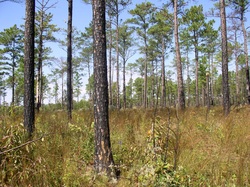Is Vigor Class an Indicator tree's health?
- based on dendrochronology
Summary

The study sites are located in Ft. Benning in the centre of Georgia, United States. This region is characterized as hot and humid summers and mild winters, and the annual precipitation is 1240mm. The tree health was evaluated with a crown condition measurement, which is vigor class (1 indicates vigorous, 2 indicates fair, 3 indicates poor vigor) using crown ratio and crown density.
The sites were once dominated or co-dominated by longleaf pine (Pinus palustris Mill.) a few decades ago. Due to fire suppression and fire exclusion, the stands have been replaced to loblolly pine (Pinus taeda L.). Although the endangered species, red-cockaded woodepecker (RCW, Picoides borealis) have been depending on loblolly pine stands, loblolly pine is less resistant for pests and diseases than longleaf pine and longleaf pine is more preferred by RCW. Thus, forest managers want to restore these stands to longleaf pine as it used to be, meanwhile it is required to protect healthy loblolly pine stands as habitats for RCW while longleaf pine stands become dominant and provide favorable habitats to RCW in the future. Forest managers need to cut some of unhealthy loblolly pines to give some gaps to longleaf pine that is shade-intolerant and to find an easy way to do so.
Measurements of tree crowns have been used extensively as indicators of the health and vigor of forest trees (S.J. Zarnoch et al, 2004). It was reported that when natural or anthropogenic stresses impact a forest, the first signs of deterioration are often observed in the tree crowns.
Crown density, crown ratio, crown position, crown vigor class, etc were meausred with diameter at breast height, height, basal area, 100 needles dry weight, soil properties. 90 plots (30 X 30m) were laid out in 2006 and field survey was conducted in both year of 2006 and 2007.
To analyze the data crown vigor class was chosen as a response variable, and other variables including foliar nutrients, needle weight (g), DBH (cm), and height (m) were predictor variables. After dividing independent variables into two groups, vigor class 1 and vigor class 2, I did T-test to find out whether there is significant difference. T-tests resulted that only DBH was significantly different (p<0.05). To figure how DBH related to vigor class I used tree ring widths and drew growth curves. And it was evident that the ring widths were larger in vigor class 1 than vigor class 2.
Other independent variables except for DBH were not correlated to vigor class, but DBH was strongly related with vigor class.
To conclude, vigor class could be used as a tool for forest managers to decide which tree could be okay to be cut.
The sites were once dominated or co-dominated by longleaf pine (Pinus palustris Mill.) a few decades ago. Due to fire suppression and fire exclusion, the stands have been replaced to loblolly pine (Pinus taeda L.). Although the endangered species, red-cockaded woodepecker (RCW, Picoides borealis) have been depending on loblolly pine stands, loblolly pine is less resistant for pests and diseases than longleaf pine and longleaf pine is more preferred by RCW. Thus, forest managers want to restore these stands to longleaf pine as it used to be, meanwhile it is required to protect healthy loblolly pine stands as habitats for RCW while longleaf pine stands become dominant and provide favorable habitats to RCW in the future. Forest managers need to cut some of unhealthy loblolly pines to give some gaps to longleaf pine that is shade-intolerant and to find an easy way to do so.
Measurements of tree crowns have been used extensively as indicators of the health and vigor of forest trees (S.J. Zarnoch et al, 2004). It was reported that when natural or anthropogenic stresses impact a forest, the first signs of deterioration are often observed in the tree crowns.
Crown density, crown ratio, crown position, crown vigor class, etc were meausred with diameter at breast height, height, basal area, 100 needles dry weight, soil properties. 90 plots (30 X 30m) were laid out in 2006 and field survey was conducted in both year of 2006 and 2007.
To analyze the data crown vigor class was chosen as a response variable, and other variables including foliar nutrients, needle weight (g), DBH (cm), and height (m) were predictor variables. After dividing independent variables into two groups, vigor class 1 and vigor class 2, I did T-test to find out whether there is significant difference. T-tests resulted that only DBH was significantly different (p<0.05). To figure how DBH related to vigor class I used tree ring widths and drew growth curves. And it was evident that the ring widths were larger in vigor class 1 than vigor class 2.
Other independent variables except for DBH were not correlated to vigor class, but DBH was strongly related with vigor class.
To conclude, vigor class could be used as a tool for forest managers to decide which tree could be okay to be cut.
